Компанія Miasphera розповіла журналістам про міфи щодо вживання медичного канабісу
16 серпня 2024 року буде введений у дію Закон України «Про внесення змін до деяких законів України щодо державного регулювання обігу рослин роду коноплі (Cannabis)» № 3528-IX. Він покликаний легалізувати обіг рослин роду конопель (канабіс) у медичних, промислових цілях, науковій та науково-технічній діяльності.
Закон викликав чимало гострих дискусій у суспільстві, а також спровокував появу міфів щодо використання медичного канабісу. На професійній дискусійній панелі «Легалізація медичного канабісу: потреба, необхідність, ризики» виділили головні з них.
Насправді є достатньо наукових даних, які підтверджують, що застосування ліків на основі медичного канабісу є ефективними при лікуванні понад 50 патологічних станів, серед них:
• неврологічні захворювання;
• захворювання травного тракту;
• хронічний біль невропатичного походження;
• при наданні паліативної допомоги тощо.
В Україні це питання особливо актуальне для наступних категорій людей:
• діти з епілепсією;
• онкохворі;
• хворі, які потребують паліативної допомоги (при невиліковних хворобах);
• ветерани війни з ПТСР.
Нині використання медичного канабісу схвалили вже 56 країн. Зокрема, Німеччина, Іспанія, Нідерланди, Італія, Чехія, Франція, Португалія, Польща, Греція, Австрія, Данія, Бельгія, Норвегія, а також Ізраїль, Великобританія, США та Канада.
Закон чітко регламентує діяльність із вирощування сортів рослин роду коноплі лише в медичних, промислових, наукових та науково-технічних цілях. Будь-яке інше використання — заборонене. Держава суворо контролюватиме обіг ліків на основі канабісу, а застосування його у рекреаційних цілях, як і раніше, залишиться під забороною і вважатиметься злочином.
Щоб виготовляти і відпускати ліки на основі медичного канабісу, аптека має отримати ліцензію на здійснення діяльності з обігу наркотичних засобів, психотропних речовин та прекурсорів та ліцензії на право провадження господарської діяльності з виробництва лікарських засобів.
Ірина Морозова, засновниця компанії Miasphera надала свій експертний коментар cайту itnews: «Для пацієнтів із певними хворобами/станами легалізація медичного канабісу є порятунком. Препарати на його основі показали свою ефективність при важких формах онкології, безсонні, неврологічних захворюваннях, хронічних болях, розсіяному склерозі, ВІЛ/СНІД, хворобі Крона, хворобі Альцгеймера та інших. Також ці засоби широко використовуються для паліативної допомоги та для полегшення стану пацієнтів з епілепсією. Яскравий приклад — синдром Драве. Це важка форма епілепсії в дітей, яка має генетичні передумови та не корелюється лікарськими засобами».
Натхненна після травневої подорожі у Львів, команда Miasphera готова поділитись своїми враженнями від участі у Львівському медичному форумі та виставки ГалМЕД.
Медичний форум, що відбувся 21-23 травня, об’єднав понад 60 компаній-учасників з України та Європи, які представили сучасне медичне, стоматологічне та реабілітаційне обладнання, вироби медичного та лабораторного призначення, харчові добавки, а також новітні методики лікування.
Вся команда Miasphera ретельно готувалась до події та була неймовірно задоволена стати учасником та офіційним партнером такого масштабного заходу. Нас чекали корисні знайомства, ділові дискусії, безліч нової інформації і, звісно, трохи чарівного старовинного Львова у вільний від роботи час 🙂
В рамках виставки ГалМЕД, Miasphera організувала науково-практичну конференцію, яка була присвячена легалізації медичного канабісу та сертифікації медичних виробів. Ми залучили до професійної дискусії лікарів, юристів, фармацевтів та фахівців дотичних до галузі.
Тема медичного канабісу викликала жваву дискусію серед присутніх, а переповнений конференц-зал був прямим підтвердженням неабиякої актуальності даного питання. Ми віримо, що наш фокус на використанні канабісу в медичних цілях знайде ще більше зацікавлених серед професійної медичної спільноти України.
Miasphera вдячна усім, хто взяв активну участь в конференції та розділив ідею легалізації та потенціалу використання канабісу у медичних цілях.
Львівський медичний форум став однією з найбільших медичних подій України, і від імені усієї команди ми безмежно вдячні організаторам, партнерам та нашим ЗСУ за можливість взяти участь у подібному заході!
І наостанок, традиційно презентуємо невеличкий фотозвіт з місця подій


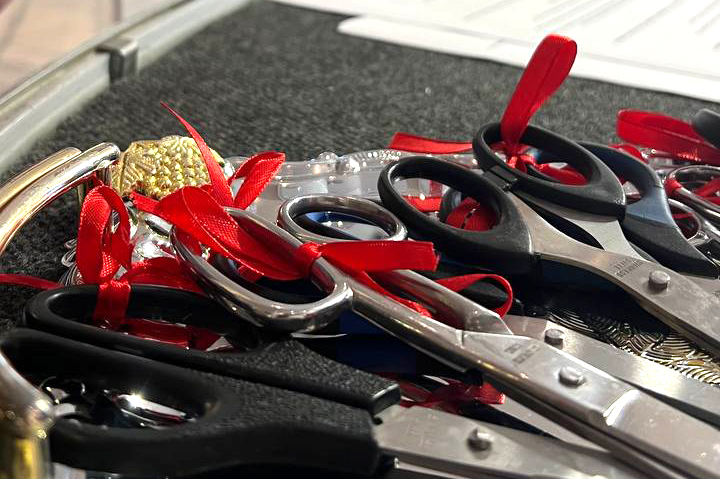


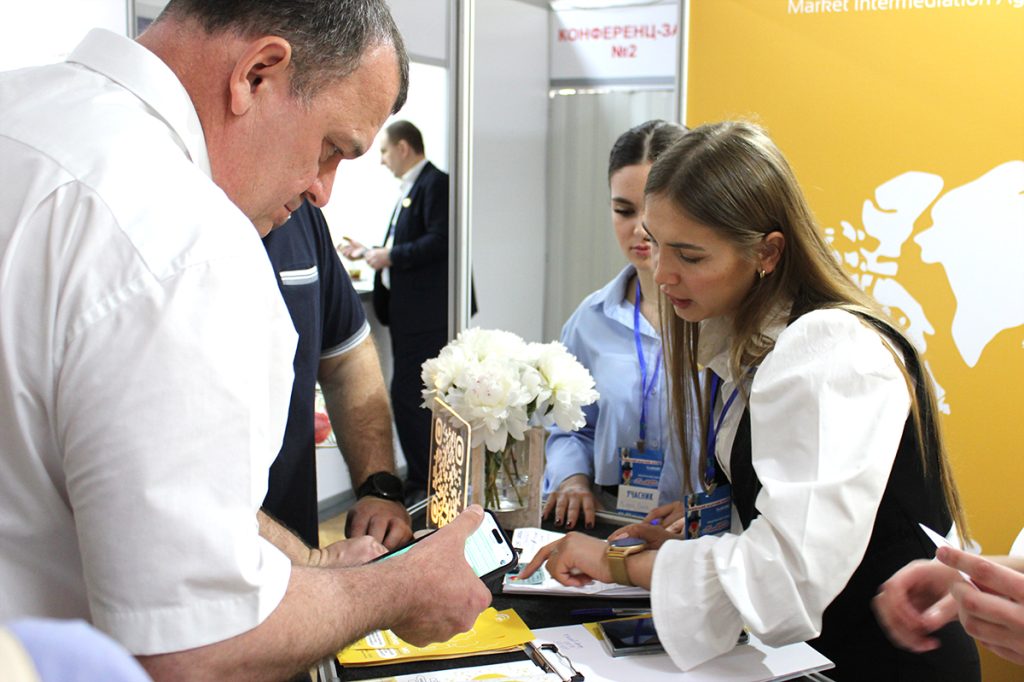


















Також наша компанія стала організатором дискусійної панелі, на тему: Актуальні виклики при легалізації медичного канабісу в Україні. Запис, ви можете подивитись на нашому Youtube каналі:
The use of cannabis in the world for any purpose has always been the subject of intense attention among medical professionals and public opinion. And our country is no exception! The stages of legalization of medical cannabis in Ukraine are still going through a thorny path of legislative vicissitudes and changes.
But in the last year, the issue of the legal status of cannabis and its legalization in Ukraine has made significant progress.
An important event took place on February 13, 2023. The President of Ukraine signed Law №7457 on regulating the circulation of medical cannabis. The law will enter into force six months after its promulgation.

The main goal of the law is to increase access to medical cannabis preparations for the treatment of a number of diseases. According to the Ministry of Health, more than 2 million Ukrainians currently need cannabis-based drugs. The adopted law declares that the circulation of varieties of plants of the genus hemp (Cannabis) for medical purposes, products of their processing and medicines produced from them, is allowed only for the purpose of their use in medical, scientific and scientific and technical practice.
Distribution and consumption of cannabis for recreational purposes among the public will be prohibited. Therefore, a potentially important new tool can be considered the introduction of a traceability system for the circulation of varieties of hemp plants.
The issue of cannabis legalization in Ukraine opens up a wide space for discussion of new business prospects. This can be a significant stimulus for the development of new sectors of the economy, not only in the field of the production of medical and cosmetic preparations based on Cannabis plants, but also the industrial cultivation and processing of hemp. Further scientific research into the properties of existing varieties of hemp and their subspecies is also of interest.
In one case or another, the adoption of the law does not mean that cannabis plants and drugs based on them will be widely available to Ukraine already this year. We can safely predict that some time after the adoption of the law, the electronic registers defined by the draft law will be formed, algorithms for controlling the circulation of plants, conditions for granting quotas, etc. will be prescribed.

Vitaliy Kovbasa, a leading lawyer at the Miasphera consulting company, talks about the prospects and conditions for the legalization of cannabis-related activities in Ukraine.
“Rejecting skepticism and assessing the situation objectively, we can state this process will not be clearly defined in the nearest time. Those who wish to pursue cannabis-related activities in the future need to worry about the legal side now. The most important thing before starting such activities is to ensure the availability of appropriate licenses and pass the appropriate certification procedures,” Vitaliy comments.
What should be taken into account?
Licensing, namely obtaining a license for:
Certification, namely:
Therefore, all types of activities related to the circulation of hemp plants are allowed only if the subjects of such activities have the appropriate licenses and undergo the appropriate certification procedures.
Disclaimer: This article doesn’t promote the use of drugs or any other illegal substances. The text is a description of the history and scientific studies of the influence of cannabis on society, man, and his physical and mental health.
В сучасному світі використання канабісу у будь-яких цілях завжди було предметом гострої уваги не тільки серед фахівців медичної галузі, а й громадськості. І наша країна не є винятком! Стадії легалізації можливості використання медичного канабісу в Україні досі проходять тернистий шлях законодавчих перипетій та змін.
Але за останній рік питання правового статусу канабісу та його легалізації в Україні значно просунулось.
13 лютого 2023 сталась важлива подія – президент України підписав закон №7457 про регулювання обігу медичного канабісу. Закон набуде чинності через шість місяців після оприлюднення.

Основною метою закону є розширення доступу до препаратів медичного Cannabis для лікування низки хвороб. Так, за даними МОЗ, препаратів на основі канабісу наразі потребують понад 2 млн українців. Прийнятий закон декларує те, що обіг сортів рослин роду коноплі (Cannabis) для медичних цілей, продуктів їх перероблення та вироблених із них лікарських засобів, допускається лише з метою їх застосування у медичній, науковій та науково-технічній практиці.
Розповсюдження та споживання канабісу для рекреаційних цілей серед населення буде заборонено, тому потенційно важливим новим інструментом можна вважати запровадження системи простежуваності обігу сортів рослин роду коноплі.
Питання легалізації канабісу в Україні відкриває широкий простір для обговорення нових перспектив діяльності. Це може стати значним стимулом для розвитку нових галузей економіки не тільки у сфері виготовлення медичних та косметичних препаратів на основі рослин Cannabis, а й промисловому вирощуванню та обробці конопель. Інтерес становлять і подальші наукові дослідження властивостей наявних сортів конопель та їх підвидів.
В тому чи іншому випадку, прийняття закону не означає, що рослини роду коноплі (Cannabis) та препарати на їх основі будуть в широкому доступі для України вже в цьому році. Можна сміливо прогнозувати, що ще певний час після прийняття закону будуть формуватись визначені законопроєктом електронні реєстри, прописуватися алгоритми для контролю обігу рослин, умови надання квот тощо.

Про перспективи та умови легалізації діяльності пов’язаної з канабісом в Україні, розповідає Віталій Ковбаса – провідний адвокат консалтингової компанії Miasphera.
«Відкинувши скепсис та оцінивши ситуацію об’єктивно, можемо стверджувати, що даний процес не буде чітко визначеним у часі. Але тим, хто в майбутньому бажає займатися діяльністю пов’язаною з обігом сортів рослин роду коноплі (Cannabis), потрібно потурбуватись про правову сторону вже зараз. Найголовніше перед початком такої діяльності – це забезпечити наявність відповідних ліцензій та пройти відповідні процедури сертифікації» – коментує закон Віталій.
Що потрібно врахувати?
Ліцензування канабісу, а саме отримання ліцензії на:
Сертифікацію, а саме:
Отже, всі види діяльності, пов’язаної з обігом сортів рослин роду Cannabis, дозволяються виключно при наявності у суб’єктів такої діяльності відповідних ліцензій та при проходженні відповідних сертифікаційних процедур.
Дисклеймер: стаття не пропагує вживання наркотиків чи будь-яких інших заборонених речовин. Текст являє собою опис історії та наукових досліджень впливу канабісу на суспільство, людину, її фізичне та ментальне здоров’я.
Цікаві статті на тему канабісу:
The first mentions of the cultivation of cannabis by mankind date back to 4000 BC. This plant has been used for thousands of years as a medicine, as a source of food, fiber, oil and paper.
The history of mankind’s interrelations with cannabis has always been influenced by various cultural, social and local trends. Cannabis was used to treat various diseases in ancient China and India. Cannabis was used in the treatment of constipation, malaria, rheumatic pains and women’s ailments. The one spread to Africa and Arab countries in the Middle Ages, where it was used mostly in medicine, as well as in cultural and religious rituals. Marijuana was first used as a pain reliever in Ancient Greece. Cannabis spread to Europe and America in the 15th century, where its use became especially popular among doctors and artists.
At the beginning of the 20th century, there was a rapid growth in the consumption of cannabis, including due to its recreational properties. At the same time, despite its great popularity, cannabis began to be banned en masse. It all started with the international opium convention signed in 1912. Initial control of the circulation of hard drugs and cannabis was introduced between the participating countries: Germany, Prussia, the Russian Empire, Great Britain, the Netherlands and many others. Marijuana was allowed to be produced and used only for medical purposes.
During the 1930s, an anti-marijuana campaign arose in the United States. The cannabis tax law was introduced in 1937.
At the same time, the popularity of hemp continued to grow in industry, for example for the production of ropes, shoes and clothing. In 1942, Henry Ford creates an experimental body made of hemp, which turned out to be 10 times stronger than steel of the same thickness. Hemp biodiesel was supposed to be the fuel for the car.
In the 1960s and 1970s, marijuana became especially popular among the counterculture youth, who became its main consumers. It becomes a kind of symbol of the hippie movement, as well as musical and artistic self-expression.
During this period, cannabis becomes the object of prohibition in many countries due to the danger of abuse and its psychotropic properties. The world history of marijuana takes a new turn in March 1961. The UN adopted the Single Convention on Narcotic Drugs. According to the cannabis convention, cannabis resin, cannabis extracts and tinctures were included in the list of narcotic drugs. The signatory countries were obliged to strengthen control over the cultivation of the plant, and to completely stop its use for purposes other than medical and scientific. Cultivation of industrial varieties of cannabis did not fall under the ban.
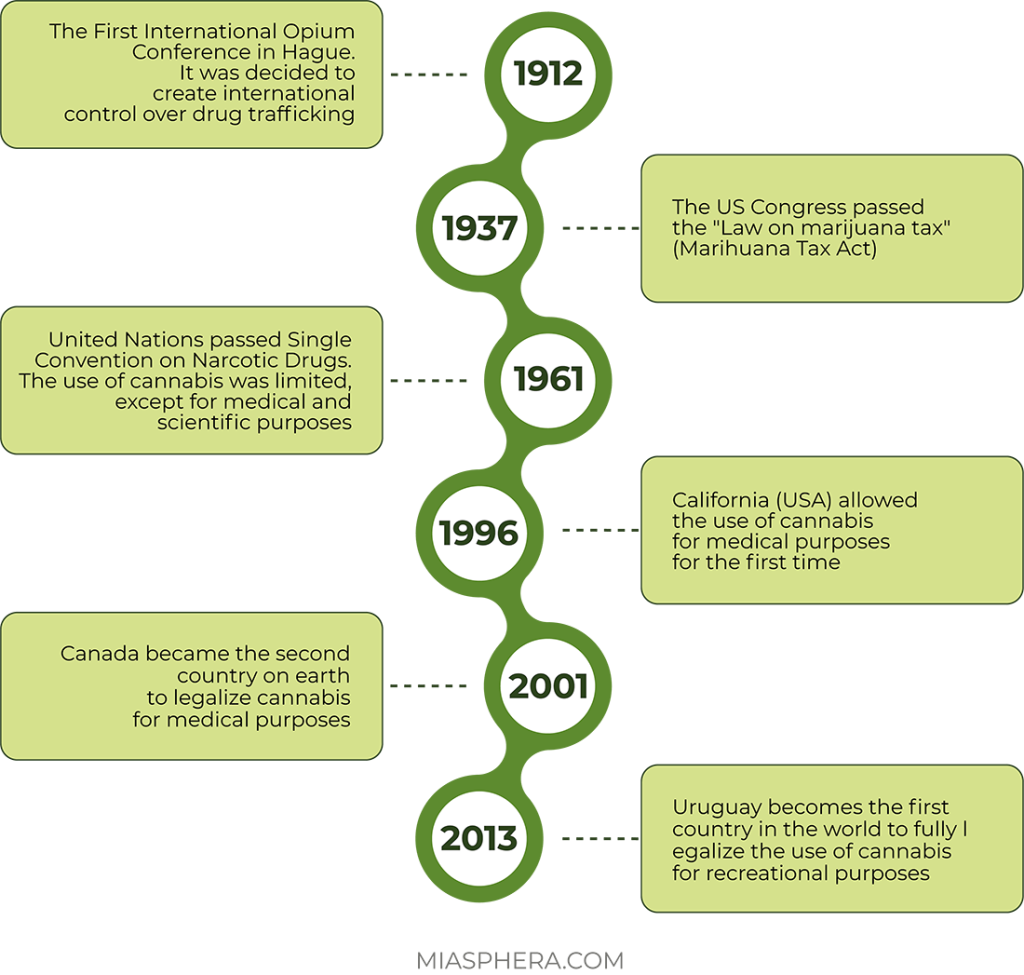
Many countries began the process of legalizing cannabis for medical and recreational purposes already at the end of the 20th century. It was an example of breaking traditional stereotypes.
Legal access to herbal cannabis and its use for medical purposes under the supervision of a doctor was first allowed in the state of California (USA) in 1996. In 2001, Canada became the second country in the world to legalize the use of cannabis for medical purposes. Since October 17, 2018, the use of cannabis for medical purposes has been allowed.
On December 10, 2013, the Uruguayan Senate passed a law on the complete decriminalization of the cultivation, sale, purchase and use of marijuana. Uruguay became the first country in the world to fully legalize cannabis.
In December 2020, the UN Commission on Narcotic Drugs removed medical cannabis and all its derivatives from the list of critically dangerous drugs, but about 25 countries still voted against this initiative.
Currently, the world market of cannabis, including for medical purposes, is in the process of rapid development. However, this development is not uniform due to different legal environments and mixed public attitudes.
In contrast to the legalization of recreational use of cannabis, more and more countries allow its medical use every year. In the last 5 years, about 20 countries in Europe (Greece, Estonia, Ireland, Luxembourg, Malta, Macedonia, Germany, Norway, Poland, Portugal, Croatia), North and South America (Argentina, Colombia, Mexico, Peru, Chile) and other countries (Australia, Philippines, Jamaica) have legalized cannabis and cannabinoids for medical purposes.
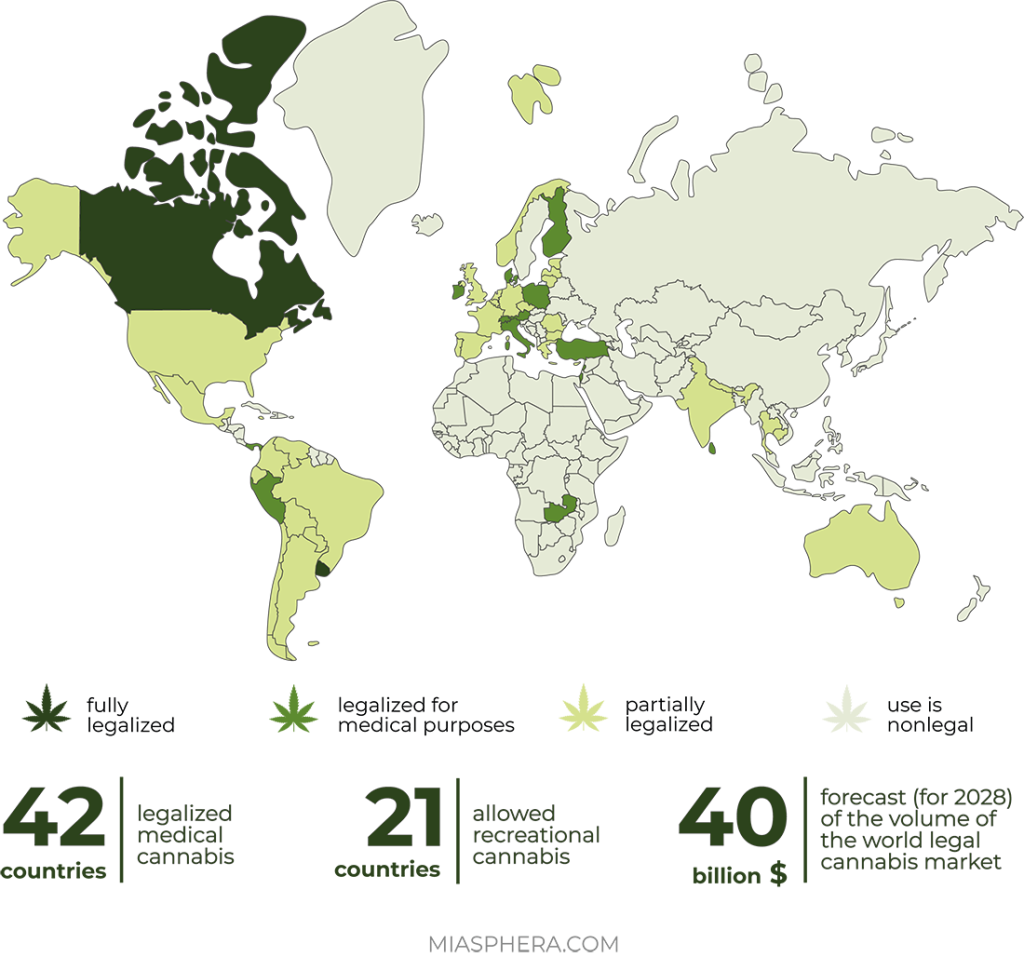
Some countries, such as Canada and the US, have adopted fully regulated frameworks that allow the cultivation, consumption and retail distribution of various cannabis-based products. So in South Africa, it is legally allowed to grow hemp, but not legalized retail sales.
In general, despite the slow changes, the world is witnessing the liberalization of the legal framework of international documents regarding the circulation of cannabis compounds and cannabinoids for medical purposes and the decriminalization of their use. Such drugs and preparations are gradually becoming available to patients in different countries.
Перші згадки про культивування канабісу людством датуються 4000 рр. до н.е. Володіючи потужними властивостями для поліпшення фізичного та психічного здоров’я, ця рослина протягом тисячоліть використовувалась як лікарський засіб, була джерелом їжі, волокон, масла та паперу.
Слід зазначити, що історія взаємовідносин людства з канабісом завжди зазнавала впливу різних культурних, соціальних та локальних тенденцій. Так, в античному Китаї та Індії канабіс використовували для лікування різних хвороб: при лікуванні запорів, малярії, ревматичних болях і жіночих недугах.
У середньовіччі канабіс поширився в Африці та в арабських країнах, де його використовували здебільшого в медицині, а також культурних та релігійних ритуалах. У Стародавній Греції марихуану вперше почали використовувати як знеболювальне під час операцій. В XV столітті канабіс поширився в Європі та Америці, де його використання набуло особливої популярності серед медиків та артистів.
На початку XX століття відбувся стрімкий ріст споживання канабісу, в тому числі завдяки його рекреаційним властивостям. Водночас попри велику популярність, канабіс почали масово забороняти. Все почалося з міжнародної опіумної конвенції, підписаної 1912 року. Вводився первинний контроль обігу важких наркотиків і конопель між країнами-учасницями: Німеччиною, Пруссією, Російською імперією, Великобританією, Нідерландами та багатьма іншими. Марихуану дозволялося виробляти та використовувати лише з медичною метою.
Впродовж 1930-х років у США виникла кампанія проти марихуани, а у 1937 році в США було введено закон про податок на канабіс.
Разом з тим популярність коноплі продовжувала зростати в промисловості, наприклад для виробництва мотузок, взуття та одягу. У 1942 році Генрі Форд створює експериментальний кузов з конопель, який виявився в 10 разів міцніший за сталь тієї ж товщини. Паливом для автомобіля мав слугувати конопляний біодизель.
У 1960-70-х роках, марихуана стає особливо популярною серед контркультурної молоді, які стають її основними споживачами. Вона стає своєрідним символом хіпі-руху, а також музичного та художнього самовираження. Саме в цей період канабіс стає об’єктом заборони у багатьох країнах через небезпеку зловживання та свої психотропні властивості. Світова історія канабісу отримує новий виток у березні 1961 року, коли ООН прийняла «Єдину конвенцію про наркотичні засоби». Внаслідок цього «канабіс, смола канабісу, екстракти та настоянки канабісу» були включені до переліку наркотичних засобів. Згідно з конвенцією, країни-підписанти були зобов’язані посилити контроль за культивуванням рослини, а її використання в інших цілях, крім медичних та наукових, повністю припинити. Під дію всесвітньої громадської заборони не попадало лише культивування промислових сортів.

Вже в наприкінці XX століття багато країн почали процес легалізації канабісу для медичних та рекреаційних цілей, тим самим ламаючи традиційні стереотипи та розглядаючи нову перспективу для використання.
Легальний доступ до рослинного канабісу та його використання в медичних цілях під наглядом лікаря вперше було дозволено у штаті Каліфорнія (США) у 1996 році. Канада стала другою у світі країною, яка легалізувала використання канабісу в медичних цілях вже 2001 році, а в рекреаційних цілях – з 17 жовтня 2018 року.
10 грудня 2013 року Сенат Уругваю ухвалив закон, про повну декриміналізацію вирощування, продажу, купівлю та використання марихуани. Таким чином, Уругвай став першою країною у світі, яка повністю легалізувала канабіс.
У грудні 2020 року Комісія ООН з наркотичних речовин виключила медичні коноплі та всі її похідні зі списку критично небезпечних наркотиків, але близько 25 країн все ж проголосували проти цієї ініціативи.
Наразі світовий ринок канабісу, у тому числі й для медичного призначення, знаходиться у процесі стрімкого розвитку. Проте цей розвиток не є однорідним через різне правове середовище та неоднозначне ставлення громадськості.
На відміну від легалізації рекреаційного використання канабісу, все більше країн рік від року дозволяють його медичне використання. Останні 5 років близько 20 країн Європи (Греція, Естонія, Ірландія, Люксембург, Мальта, Македонія, Німеччина, Норвегія, Польща, Португалія, Хорватія), Північної та Південної Америки (Аргентина, Колумбія, Мексика, Перу, Чилі) та інші країни (Австралія, Філіппіни, Ямайка) легалізували канабіс та канабіноїди для медичних цілей у тому, чи іншому вигляді.
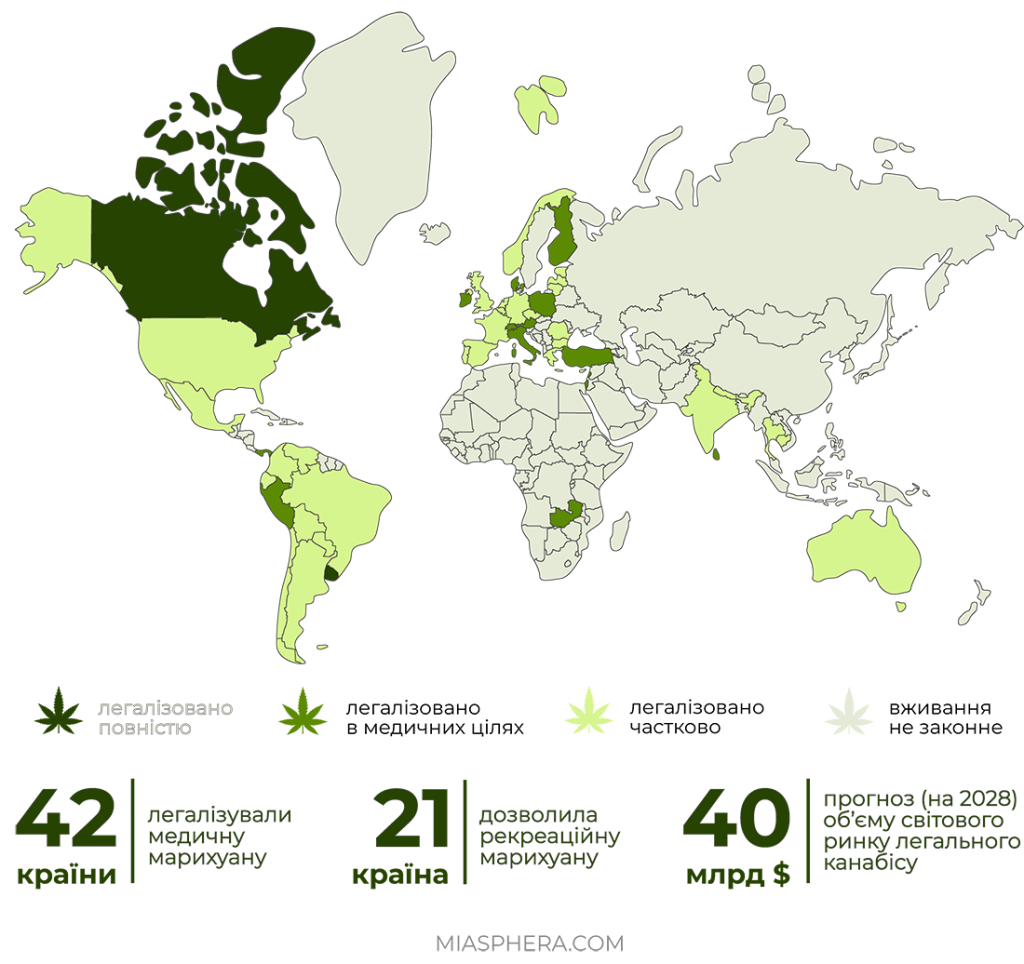
Деякі країни, такі як Канада та США, дозволяють вирощувати, споживати та роздрібно розповсюджувати різні продукти на основі канабісу. Так в Південній Африці, законодавчо дозволено вирощувати коноплі, але не легалізовано роздрібні продажі.
Попри повільні зміни у світі спостерігається лібералізація нормативно-правової бази міжнародних документів, що стосуються обігу сполук канабісу та канабіноїдів у медичних цілях та декриміналізація їх застосування. Такі лікарські засоби та препарати поступово стають доступними для пацієнтів в різних країнах.
Увага! Стаття розміщена з пізнавальною метою і не пропагує вживання наркотиків.
Більше про відмінності між поняттями «коноплі», «канабіс» та «марихуана» читайте в нашій статті за посиланням.
The large number of restrictions on the production and use of cannabis in different countries often lead to misunderstandings and confusion in the concepts themselves. Not everyone realizes why there are three different names – cannabis, marijuana and hemp and what exactly is the difference between them. And those who do not know about the existence of industrial varieties are hostile to all cannabis in general.
So, cannabis, hemp or marijuana – which is correctly?
Answer: all names are correct! But from the point of view of botany, medicine and law are completely different things. There are different subspecies and products made from the same hemp. Let’s figure out what hemp is and why there’s been so much talk about it.
The plant of the genus Cannabis or Hemp is an agricultural crop characterized by jagged leaves and a characteristic smell. Botanists divide these plants by structure and classify them based on morphology, physiology, and origin. The most famous subspecies are Sativa and Indica or their hybrids.
Sativa is a tall plant with thin leaves that is traditionally grown in Latin America, North Africa, and Southeast Asia. The subspecies has an elevated level of tetrahydrocannabinol (THC).
Indica is a low-growing subspecies with a high level of cannabidiol (CBD) and is grown mainly in the mountainous regions of India and Pakistan.
There is also a wild subspecies – Ruderalis. It is less common, but on its basis all cultivated varieties of technical hemp with almost zero content of tetrahydrocannabinol (THC) were bred. It is known for its feature of autoflowering, depending on age, not light cycles. Due to its low THC content, it is not used for recreational or medical purposes.
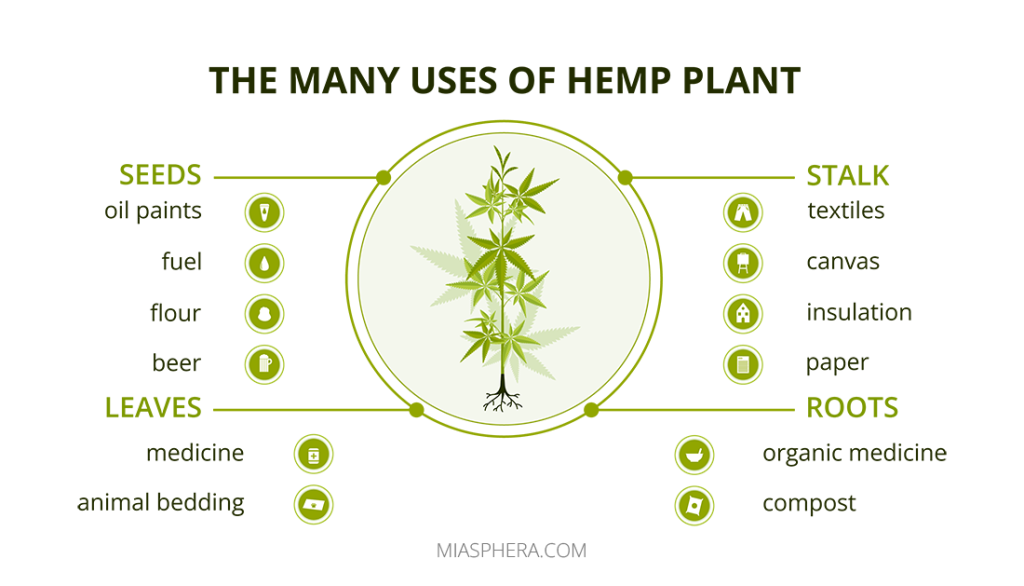
In general, cannabis is the Latin name of the plant, which also refers to medical hemp varieties and hemp-based products for therapeutic purposes. Traditionally, medical cannabis has a balanced CBD content and low THC levels.
Marijuana is a smoking mixture of dried female flowers of sativa and indica. Marijuana has a higher percentage of psychoactive substances (THC more than 0.3%) compared to hemp and has psychotropic properties (a mild drug).
Why are there three names?
In connection with the legalization of medical cannabis, it became necessary to name different subspecies of hemp and products based on them. Thus, manufacturers distanced those who needed to use these plants specifically for medicinal purposes from users for recreational consumption.
How to determine the legal status of the cannabis plant?
These names should be clearly distinguished. So, knowing the properties, we can summarize that:
Hemp is an agricultural crop that includes all varieties of Cannabis Ruderalis. Hemp is a source of ecological textiles and paper, widely used for industrial purposes.
Cannabis is the designation of specialized varieties bred for therapeutic purposes, regardless of their narcotic properties.
Marijuana is a smoking mixture of dried female flowers of sativa and indica, which has the properties of a light narcotic.
Medical Marijuana or Medical Cannabis – This term is used specifically for the Sativa derivatives of cannabis that are used to relieve the symptoms caused by certain diseases.
What is the difference between medical and recreational marijuana?
The main difference is in the THC content. It is incorrect to equate medical marijuana with recreational marijuana, since its purpose is not to bring pleasure, but to relieve pain symptoms. And therefore, medical cannabis is specially bred varieties with a changed THC content.
Currently, many varieties of cannabis Sativa plants have been bred specifically for medical use.
The main active substance is cannabidiol (CBD). The results of scientific research show that herbal preparations with CBD effectively block various types of pain, increase appetite, help overcome depressive states, and prevent epileptic attacks. This is an important remedy for people suffering from constant pain, oncology and AIDS.
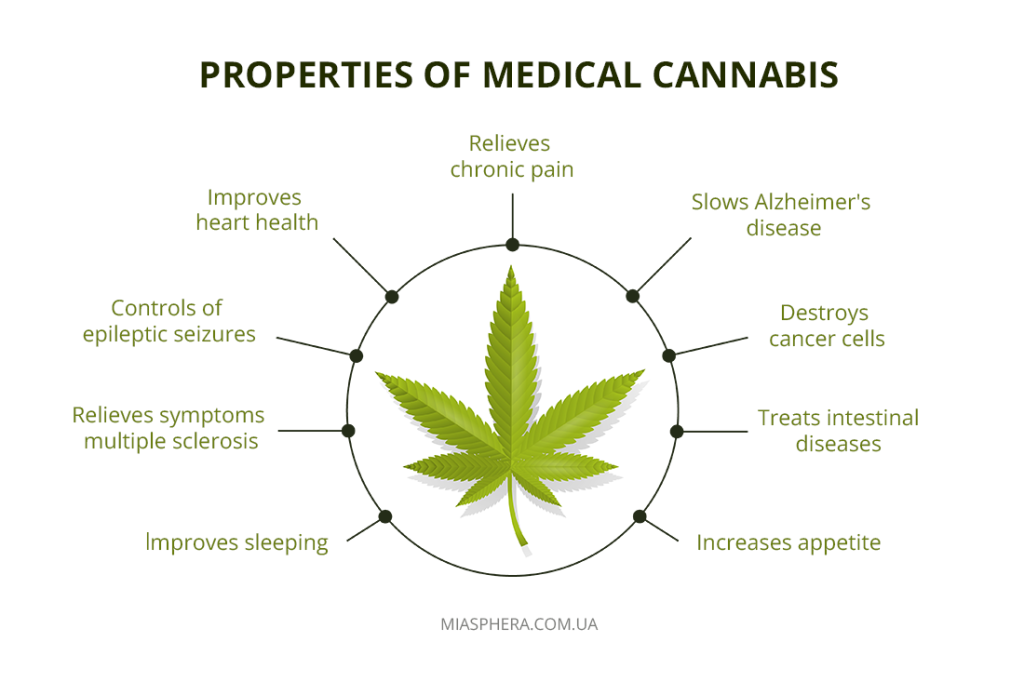
Medical cannabis has shown potential in alleviating symptoms associated with neurological diseases such as epilepsy, multiple sclerosis, Parkinson’s disease, Alzheimer’s disease, and neuropathic pain. But it is important to understand that cannabis is not a panacea and such treatment may not be useful for everyone.
Currently, numerous studies are being conducted around the world on the effect of medical cannabis in the treatment of particularly complex diseases.
But at the same time, the ambiguous legal status of different chemotypes makes it difficult to study the properties of cannabis. A mandatory condition for conducting research is a special license, obtaining which is a rather bureaucratic procedure.
We hope that science will stubbornly move forward in this matter, discovering new useful ways of using hemp and its derivatives in medicine, chemical industry, industry and agriculture.
WARNING! The article is posted for educational purposes and does not promote the use of drugs. We hope our publication brought a scientific understanding of the topic and helped to understand the differences in terms.